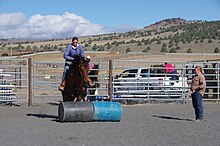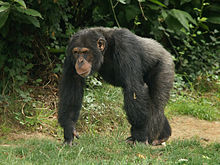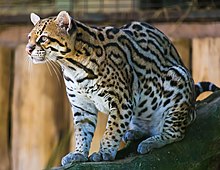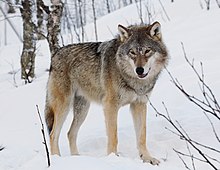Captivity (animal)

| Part of a series on |
| Animal rights |
|---|
Animal captivity is the confinement of domestic and wild animals.. Animal captivity may be categorized according to the particular motives, objectives, and conditions of the confinement.
History

All throughout history, domestic animals like pets and livestock were kept in captivity and tended by humans. However, pets and livestock were not the only animals to be put in captivity and receive human care because wild animals had this as well. Despite the fact that wild animals have been harbored by humans for thousands of years, this captivity has not always come close to present zoos. Some were failed domestication attempts. Furthermore, the wealthy, predominantly the aristocrats and kings, collected wild animals for various reasons. The affluent built the first zoos as personal collections to demonstrate their dominance and wealth. These private collections of animals were known as menageries. Contrary to domestication, the ferociousness and natural behaviour of the wild animals were preserved and exhibited. Today, zoos claim to have other reasons for keeping animals under human care: conservation, education and science.
Behavior of animals in captivity
Captive animals, especially those not domesticated, sometimes can develop abnormal behaviours.
One type of abnormal behaviour is
Many who keep animals in captivity attempt to prevent or decrease stereotypical behavior by introducing stimuli, a process known as environmental enrichment. The goals of environmental enrichment are to make environments more complex and fluid, offer more engaging and complex processes, and give animals more chances to make decisions. Techniques that are commonly used to provide environmental enrichment include social, occupation, physical, sensory, and nutritional.[4]
Another type of abnormal behavior shown in captive animals is self-injurious behavior (SIB). Self-injurious behavior indicates any activity that involves biting, scratching, hitting, hair plucking, or
The proximal causes of self-injurious behavior have been widely studied in captive
Nonsocial factors include the presence of a small cut, a wound or irritant, cold weather, human contact, and frequent zoo visitors.[6] For example, a study has shown that zoo visitors density positively correlates with the number of gorillas banging on the barrier, and that low zoo visitors density caused gorillas to behave in a more relaxed way. Captive animals often cannot escape the attention and disruption caused by the general public, and the stress resulting from this lack of environmental control may lead to an increased rate of self-injurious behaviors.[8]
There are studies that suggest the many abnormal captive behaviors, including
Why animals are placed in captivity
Wild animals may be placed in captivity for conservation, studies, exotic pet trade, and

Annually, it is subjected that thousands of wild animals end up in captivity due to the wild animal trade. These animals can be held in captivity because of the overabundance of their population in roadside zoos. Additional reasons as to why animals may end up in captivity is because animals are captured from their original habitat, come from animal breeders, or come from the black market. When wild animals are captured and held in captivity, then they may be sold in pet stores, auction sales, or the World Wide Web.[13]
Zoos' impact on animal captivity

Zoos are known as a place where visitors come in to see wild animals.[14] This means zoos may keep animals in confinement. For example, zoos may keep animals captive as a means to save them from going extinct. More specifically, in 2020 the Science Advances published a study where they concluded that the work and population of human beings has affected the growth of animals going extinct around the world. The uproar of animals going extinct has caused zoos to use their captive breeding programs on endangered animals in an effort to create a stronger population. It is said that zoos are responsible for reducing the number of animals on the endangered species list and from extinction.[15][16]
Zoos could also be known as a place where animals are put into after they are taken out of their natural habitat. When animals are pulled out from their native habitat and taken to a location they are unfamiliar with, then it is said that animals may experience shock and poor mental health. Furthermore, some wild animals have died inside zoos due to the shock of being placed in an unknown setting. To be more specific, this can also mean that taking animals away from their native habitat can possibly disrupt their way of living.[citation needed]
List of wild animals in America commonly held in captivity
| Name of animal and classification[citation needed] | Animal description | Lifespan in the wild | Lifespan in captivity | Photo of animal |
|---|---|---|---|---|
| Alligators | The American alligators are considered to be crocodilians. Alligators may grow taller than 12 feet and weigh around 1,000 pounds (454 kg). This creature may be found in the southeastern area of the United States.[17] More specifically, places such as Florida, Southern Virginia Border, Rio Grande (Texas), and west of the Gulf Coast. Alligators live in areas such as lakes, rivers, swamps, and wetlands. Furthermore, alligators' bodies are covered with scutes (scales) or osteoderms (bone skin)[18][19] | 35–50 years | 65–80 years[20] |  |
Bears
|
Bears come in all different shapes and sizes due to where they live and how much food they have in their environment.[21] For example, the panda can weigh around 300 pounds (136 kg)[22] and the male polar bear can weigh from 550-1700 pounds (249 to 771 kg).[23] The range of bear heights can go from the panda who can be 4 feet tall[24] to the polar bear who can be up to 11 feet tall.[25] | 20–30 years | Around 40 years[26] |  |
Cougars
|
mountain lions or pumas. The cougars' appearance is said to look like a larger version of a cat. The adult male cougar may weigh 200 pounds (91 kg) and the adult female may weigh 120 pounds (54 kg).[27] The range of length for an adult cougar is said to be from 42 to 54 inches, including the tail that is 3 feet long.[28]
|
Around 12 years | Up to 20 years[29] |  |
Chimpanzees
|
Chimpanzees are said to be social animals and their habitat is in the forests of Central Africa.[30] In terms of appearance, chimpanzees have long black or brown hair that covers their body.[31] Additionally, chimpanzees can be 3 feet tall. The females may weigh from 70 to 100 pounds (32 to 45 kg) and the males may weigh from 90 to 120 pounds (41 to 54 kg). | About 33 years[32] | 31.7 years for males and 38.7 years for females [33] |  |
Lions
|
Lions are considered to be muscular and have broad bodies. In terms of their appearance, male lions have a mane of hair that surrounds the neck area. Lions also tend to have a yellow to gold coat. Additionally, male lions tend to be 10 feet in length and weigh around 330 to 550 pounds (150 kg to 249 kg). On the other hand, female lions, also known as lionesses,[34] tend to be 9 feet in length and weigh between 265 and 395 pounds (120 kg to 179).[35][36] Moreover, lions can be found in continents such as Africa, Asia, and Europe. More specifically, lions live in places such as Benin, Botswana, Cameroon, India, Kenya, Mozambique, Namibia, South Africa, Tanzania, and Zambia.[37] | 12 to 16 years | Around 25 years[38] |  |
Ocelots
|
About 12 years | Around 20 years[42] |  | |
Servals
|
wild cat, has stripes and spots on its body. Serval can be small to medium-sized in length. To be more specific, this animal is approximately between 1 and 2 meters long. In terms of weight, Servals weigh around 20 to 40 pounds (9 to 19 kg).[43] This animal lives close to the savannas in the central and south area of Africa. More specifically, servals live where there are rivers and streams.[44]
|
10 to 12 years | Up to 20 years and higher[45] |  |
Tigers
|
Tigers have many subspecies and are known as one of the largest cats in the world. More specifically, Amur tigers are 10 feet long and weigh around 660 pounds (300 kg). In contrast, the Sumatran tigers, the smaller subspecies of tigers, are about 8 feet long and weigh around 310 pounds (141 kg). The female tigers for every subspecies are stated to be smaller in size and lighter in weight compared to the males. Furthermore, tigers may be found in South and Southeast Asia, Eastern Russia, and China.[46]
|
10 to 25 years | Up to 20 years[47] |   |
Wolves
|
There are different subspecies of North Idaho, North Michigan, North Wisconsin, Northeast Oregon, West Montana, and in Yellowstone park which is located in Wyoming.[48]
|
Typically no more than 10 years[49] | Up to 20 years[50] |  |
Honey Badgers
|
Mellivora capensis, commonly known as honey badgers, are considered small mammals that weigh from 11 to 35 pounds[51]. Mellivora Capensis have been observed to defend themselves against Leopards, Pythons, and Crocodiles. Honey Badgers can be found in dry areas, grasslands, and forests in Africa, Asia, and the Indian Subcontinent[52]. Honey Badgers are considered solitary mammals and have black and white fur with large sharp claws as distinctive features[52]. | 7-8 years in the wild [53] | Approximately 24 years (longest recorded 31 years)[53] |  |
See also
|
Animal husbandry
Animal rights
|
Wild animal keeping
|
References
- ^ "Is that animal wild or domesticated? | World Animal Protection". www.worldanimalprotection.ca. Retrieved 2023-04-25.
- ^ Definitions, 1911 Chapter 27 1 and 2 Geo 5; "...the expression "captive animal" means any animal (not being a domestic animal) of whatsoever kind or species, and whether a quadruped or not, including any bird, fish, or reptile, which is in captivity, or confinement, or which is maimed, pinioned, or subjected to any appliance or contrivance for the purpose of hindering or preventing the animals escape from captivity or confinement..."; Protection of Animals Act 1911; http://www.legislation.gov.uk/ukpga/Geo5/1-2/27
- ^ "What Is Zoochosis and How Do Animals Get It?". IDA USA. Retrieved 2022-10-26.
- ^ "Environmental enrichment". www.ufaw.org.uk. Retrieved 2022-10-26.
- ^ PMID 17209750.
- ^ S2CID 29918666.
- S2CID 21576022.
- .
- ^ PMID 25635151.
- PMID 14510519.
- PMID 31824674.
- ^ "How Zoos and Aquariums Protect Endangered Species". www.aza.org. Retrieved 2023-04-29.
- ^ "Captive Animals - Most states have no laws governing captive wild animals". Animal Legal Defense Fund. Retrieved 2023-04-29.
- ^ "zoo". education.nationalgeographic.org. Retrieved 2023-05-09.
- ^ Barrelet, Agnes (2021-06-24). "How Zoos Improve the Lives of Animals". Children's Nature Retreat. Retrieved 2023-05-09.
- ^ Society, National Geographic (2010-11-11). "Captive Breeding and Species Survival". National Geographic Society. Retrieved 2023-05-09.
- ^ "American Alligator". National Wildlife Federation. Retrieved 2023-05-07.
- ^ "American Alligator - Alligator Mississippiensis - NatureWorks". nhpbs.org. Retrieved 2023-05-11.
- ^ "Osteoderm Fossils: More than Skin Deep | State Historical Society of North Dakota Blog". blog.statemuseum.nd.gov. Retrieved 2023-05-11.
- ^ "American Alligator | Stone Zoo". www.zoonewengland.org. Retrieved 2023-05-09.
- ^ "Bears of North America". Be Bear Aware Campaign. Retrieved 2023-05-07.
- ^ Schmidt, Amanda. "Panda Fact Sheet | Blog | Nature | PBS". Nature. Retrieved 2023-05-11.
- ^ Schmidt, Amanda. "Polar Bear Fact Sheet | Blog | Nature | PBS". Nature. Retrieved 2023-05-11.
- ^ Schmidt, Amanda. "Panda Fact Sheet | Blog | Nature | PBS". Nature. Retrieved 2023-05-07.
- ^ [email protected]. "Polar Bear Species Profile, Alaska Department of Fish and Game". www.adfg.alaska.gov. Retrieved 2023-05-07.
- ^ "How Long Do Brown Bears Live? Discover the Brown Bear Lifespan (with Photos) - WildlifeTrip". wildlifetrip.org. Retrieved 2023-05-07.
- ^ "Cougar Facts for Kids - NatureMapping". naturemappingfoundation.org. Retrieved 2023-05-07.
- ^ "Cougar Facts - NatureMapping". naturemappingfoundation.org. Retrieved 2023-05-07.
- ^ "Cougar: Key Facts". Forest Wildlife. Retrieved 2023-05-07.
- ^ "Chimpanzees | Species | WWF". World Wildlife Fund. Retrieved 2023-05-07.
- ^ "Chimpanzee | San Diego Zoo Animals & Plants". animals.sandiegozoo.org. Retrieved 2023-05-07.
- ^ Cummings, Mike (2017-03-20). "Yale-led study: Wild chimpanzees have surprisingly long life spans". YaleNews. Retrieved 2023-05-07.
- ^ J.B (2013-03-08). "How long do chimpanzees live?". Chimpanzee Sanctuary Northwest. Retrieved 2023-05-07.
- ^ "Meet the Lion Family - Male, Female & Cub". Alert. Retrieved 2023-05-08.
- ^ "Lion". Smithsonian's National Zoo. 2016-04-25. Retrieved 2023-05-08.
- ^ Schmidt, Amanda. "Lion Fact Sheet | Blog | Nature | PBS". Nature. Retrieved 2023-05-08.
- ^ "10 Places Where Lions Live in the Wild (with Photos) - WildlifeTrip". wildlifetrip.org. Retrieved 2023-05-08.
- ^ Society, National Geographic (2011-09-21). "Big Cats in Captivity". National Geographic Society. Retrieved 2023-05-08.
- ^ "Natural history". www.biologicaldiversity.org. Retrieved 2023-05-07.
- ^ "Ocelot - Leopardus pardalis - NatureWorks". nhpbs.org. Retrieved 2023-05-11.
- ^ "Ocelot (Leopardus pardalis)". tpwd.texas.gov. Retrieved 2023-05-12.
- ^ Admin (2016-08-23). "Ocelot". Carolina Tiger Rescue. Retrieved 2023-05-07.
- ^ "Serval Facts and Information | SeaWorld Parks & Entertainment". seaworld.org. Retrieved 2023-05-07.
- ^ "Serval | San Diego Zoo Animals & Plants". animals.sandiegozoo.org. Retrieved 2023-05-07.
- ^ Admin (2016-08-23). "Serval". Carolina Tiger Rescue. Retrieved 2023-05-07.
- ^ "Tiger". Smithsonian's National Zoo. 2016-04-25. Retrieved 2023-05-07.
- ^ "Tiger". Smithsonian's National Zoo. 2016-04-25. Retrieved 2023-05-09.
- ^ "Gray Wolf". National Wildlife Federation. Retrieved 2023-05-07.
- ^ Mech, David (1988). "Longevity wild wolves" (PDF).
- ^ "FAQ about wolves". IFAW. Retrieved 2023-05-07.
- ^ "Honey Badger (Mellivora Capensis)". A-Z-Animals. March 14, 2024. Retrieved March 14, 2024.
{{cite web}}: CS1 maint: url-status (link) - ^ a b "Honey Badger (Ratel) | San Diego Zoo Animals & Plants". animals.sandiegozoo.org. Retrieved 2024-04-23.
- ^ a b "Honey badger (Mellivora capensis) longevity, ageing, and life history". genomics.senescence.info. Retrieved 2024-04-23.
